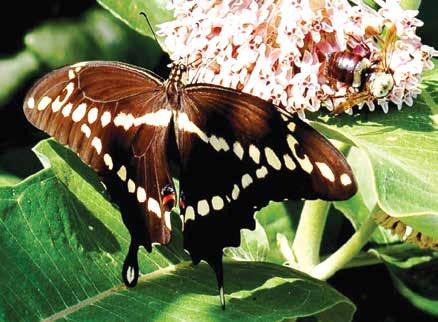Pollinator habitat design botanical and biological elements to consider
W
ant to break away from the traditional American lawn and bring life, color, beauty, and ecological function to your landscape? Then consider installing a pollinator habitat! These habitats attract and nourish butterflies, bees, and other pollinators. The fruits from pollination services, and the caterpillars of moths and butterflies, provide food for songbirds and other animals. Adding botanical diversity will ignite the biodiversity and ecosystem services on your property. Pollinator habitats can be designed to work in tandem with the natural biology and needs of the pollinators you want to support. Butterflies Let’s use the monarch butterfly as an example here. Most butterflies need a specific host plant to complete their lifecycle and rear their young. For monarchs that plant is milkweed (Asclepias spp.). They also need nectar sources for migration and throughout the breeding season. Thus, two things are needed to attract monarchs to the garden; 1) the preferred host plant upon which eggs will be laid, and 2) nectar plants to provide nourishment and sustain their flight (MayOctober). Now that we know what to plant, how should the habitat be arranged? Monarchs use visual ques (leaf shape/plant architecture) to find their milkweed hosts and lay their eggs. This behavior suggests that the milkweed should be placed in the most visually apparent and accessible spot in the garden, making it as easy for monarchs to find as possible. This can be achieved by placing milkweeds in the perimeter of the garden. Isolate some of the milkweeds by several feet from other plants so they create a strong visual silhouette and are accessible to butterflies from head to toe.
Place habitat in areas that use the natural flow of your property. Butterflies and other flying animals use tree lines, paths, streams, and roads as flyways. Use natural flyways to your advantage and lead butterflies to your pollinator habitat. Bees Most species of bees are small solitary creatures, very different from the social honey and bumble bees we are so familiar with. Some bees are active early in the spring and others arise in the heat of summer and linger late into the fall. The thing all bees have in common though, is the need for nectar and pollen to feed themselves and their young. To attract and support bees to your property, choose a mixture of plants that provide season-long nectar and pollen resources. Use native plants when possible and sprinkle in non-native (non-invasive) plants to fill in bloom gaps. Have both mixtures and patches of single-species flowers in your habitat. Patches, or a flowering tree with hundreds of blooms, facilitate efficient bee foraging because they offer a large pollen and nectar re-
ADAM M. BAKER Ecology Expert 8
May 2021 | kcgmag.com
source. Bees learn what type of flowers in the landscape are high quality food sources and continue to revisit those flowers until the resource is depleted. Social bees have the added advantage of being able to communicate the type and location of flowers to their hive mates.
Habitat Establish habitat in an open area where it will get lots of sun. Plants can be established via seed or as plants/plugs. When creating habitat from seed, ideally you want to start preparation of the seed bed the fall before planting for the greatest success. After seeding you may add in slow germinating species as plants or plugs, such as milkweed, to give them a head start. Use a mixture of annuals, perennials, and woody species to provide season long nectar and pollen as well as visual interest to your pollinator habitat. Flowers will also support other pollinators such as flies, beetles, and moths. Such habitats will sustain populations of native predators and parasites that will help to maintain a healthy and productive ecosystem. Think about the biology and needs of the animals you are trying to attract and support when designing your own pollinator habitat and have fun!
American Lady and Bee on coneflower.
Dr. Adam M. Baker provides support for the Midwest offices, educational training, and conducts research as a Technical Advisor with the Davey Institute. His expertise is in pollinator ecology, conservation, plant/ insect interactions, and the responsible management of pests in the urban landscape. He received a BS in Agricultural Sciences with a minor in English and a PhD in Entomology from the University of Kentucky.













